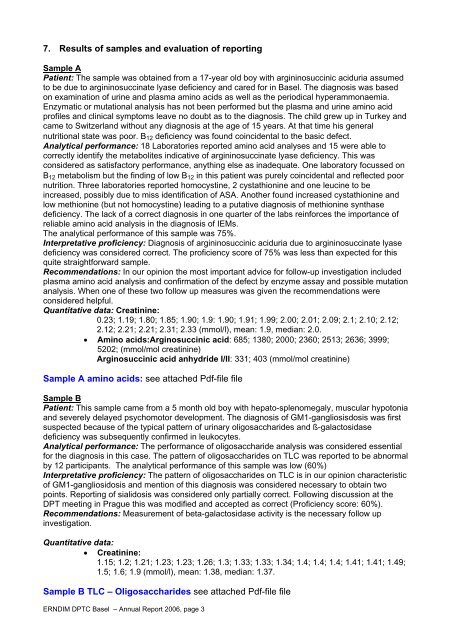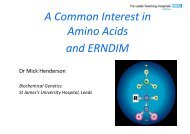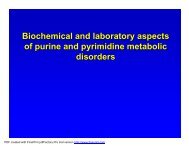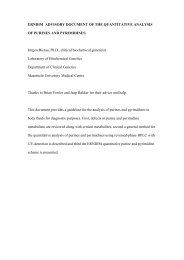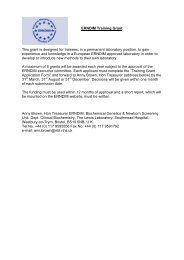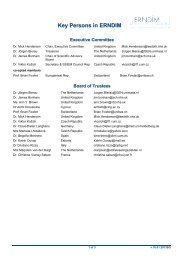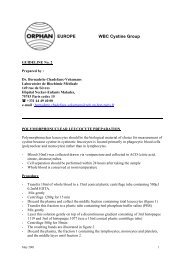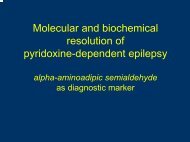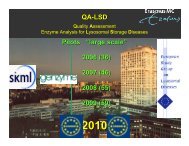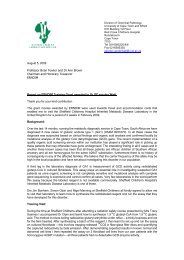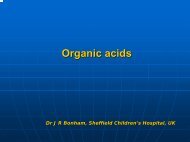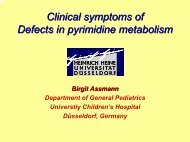DPT Report 2006 - ERNDIM
DPT Report 2006 - ERNDIM
DPT Report 2006 - ERNDIM
You also want an ePaper? Increase the reach of your titles
YUMPU automatically turns print PDFs into web optimized ePapers that Google loves.
7. Results of samples and evaluation of reporting<br />
Sample A<br />
Patient: The sample was obtained from a 17-year old boy with argininosuccinic aciduria assumed<br />
to be due to argininosuccinate lyase deficiency and cared for in Basel. The diagnosis was based<br />
on examination of urine and plasma amino acids as well as the periodical hyperammonaemia.<br />
Enzymatic or mutational analysis has not been performed but the plasma and urine amino acid<br />
profiles and clinical symptoms leave no doubt as to the diagnosis. The child grew up in Turkey and<br />
came to Switzerland without any diagnosis at the age of 15 years. At that time his general<br />
nutritional state was poor. B12 deficiency was found coincidental to the basic defect.<br />
Analytical performance: 18 Laboratories reported amino acid analyses and 15 were able to<br />
correctly identify the metabolites indicative of argininosuccinate lyase deficiency. This was<br />
considered as satisfactory performance, anything else as inadequate. One laboratory focussed on<br />
B12 metabolism but the finding of low B12 in this patient was purely coincidental and reflected poor<br />
nutrition. Three laboratories reported homocystine, 2 cystathionine and one leucine to be<br />
increased, possibly due to miss identification of ASA. Another found increased cystathionine and<br />
low methionine (but not homocystine) leading to a putative diagnosis of methionine synthase<br />
deficiency. The lack of a correct diagnosis in one quarter of the labs reinforces the importance of<br />
reliable amino acid analysis in the diagnosis of IEMs.<br />
The analytical performance of this sample was 75%.<br />
Interpretative proficiency: Diagnosis of argininosuccinic aciduria due to argininosuccinate lyase<br />
deficiency was considered correct. The proficiency score of 75% was less than expected for this<br />
quite straightforward sample.<br />
Recommendations: In our opinion the most important advice for follow-up investigation included<br />
plasma amino acid analysis and confirmation of the defect by enzyme assay and possible mutation<br />
analysis. When one of these two follow up measures was given the recommendations were<br />
considered helpful.<br />
Quantitative data: Creatinine:<br />
0.23; 1.19; 1.80; 1.85; 1.90; 1.9: 1.90; 1.91; 1.99; 2.00; 2.01; 2.09; 2.1; 2.10; 2.12;<br />
2.12; 2.21; 2.21; 2.31; 2.33 (mmol/l), mean: 1.9, median: 2.0.<br />
• Amino acids:Arginosuccinic acid: 685; 1380; 2000; 2360; 2513; 2636; 3999;<br />
5202; (mmol/mol creatinine)<br />
Arginosuccinic acid anhydride I/II: 331; 403 (mmol/mol creatinine)<br />
Sample A amino acids: see attached Pdf-file file<br />
Sample B<br />
Patient: This sample came from a 5 month old boy with hepato-splenomegaly, muscular hypotonia<br />
and severely delayed psychomotor development. The diagnosis of GM1-gangliosisdosis was first<br />
suspected because of the typical pattern of urinary oligosaccharides and ß-galactosidase<br />
deficiency was subsequently confirmed in leukocytes.<br />
Analytical performance: The performance of oligosaccharide analysis was considered essential<br />
for the diagnosis in this case. The pattern of oligosaccharides on TLC was reported to be abnormal<br />
by 12 participants. The analytical performance of this sample was low (60%)<br />
Interpretative proficiency: The pattern of oligosaccharides on TLC is in our opinion characteristic<br />
of GM1-gangliosidosis and mention of this diagnosis was considered necessary to obtain two<br />
points. <strong>Report</strong>ing of sialidosis was considered only partially correct. Following discussion at the<br />
<strong>DPT</strong> meeting in Prague this was modified and accepted as correct (Proficiency score: 60%).<br />
Recommendations: Measurement of beta-galactosidase activity is the necessary follow up<br />
investigation.<br />
Quantitative data:<br />
• Creatinine:<br />
1.15; 1.2; 1.21; 1.23; 1.23; 1.26; 1.3; 1.33; 1.33; 1.34; 1.4; 1.4; 1.4; 1.41; 1.41; 1.49;<br />
1.5; 1.6; 1.9 (mmol/l), mean: 1.38, median: 1.37.<br />
Sample B TLC – Oligosaccharides see attached Pdf-file file<br />
<strong>ERNDIM</strong> <strong>DPT</strong>C Basel – Annual <strong>Report</strong> <strong>2006</strong>, page 3


